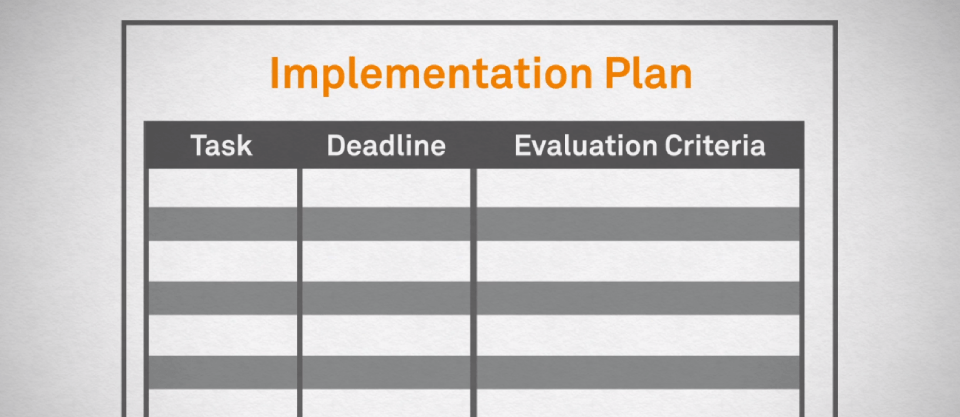
Learn to Make a Project Plan in 10 Simple Steps
"Project" is perhaps the most-used term in the business world. A project is a set of activities aimed at achieving a specific goal. It is a broad definition and can be modified to meet the needs of any industry. A project plan is one of the most fundamental aspects of a project.
A project plan is, essentially, a schedule and consists of documents that define the vision of the project. These documents can change as the project progresses to accommodate new requests from the stakeholders.
The plan itself may differ from industry to industry and even from company to company. The fundamentals, however, stay the same. You can break down the process for creating a project plan into the following ten steps to help you get a better understanding of the task.
Get Certified in Project Management
Transform your project management skills and learn how to apply them as an agile project manager.

1. Stakeholder identification and briefing
The first step in project management is to identify the people who will be affected by the project. It includes your customers as well as the end-users of the product. You need to understand the customer requirements and translate them into a problem for the project. Your project plan will centre around the solution to this problem. Therefore, the problem statement must be detailed. The stakeholders should also agree with your problem statement.
2. Define roles and responsibilities
A project plan, as stated above, comprises various documents. It is not possible for everyone involved in the project to review and agree to every aspect of the project. Every person involved in the project needs to be apprised of their roles and responsibility. The project managers are responsible for developing the project plan. The sponsors and business experts should review and approve every aspect of the project, and therefore, they should read every document that is a part of the project plan. The others involved in the project, such as the team members, auditors, end users, procurement specialists, etc. only need to read and review the documents pertaining to their responsibility.
3. Define the mission of the project and create an implementation plan
The mission lays down the path for the development of the project. The mission statement will act as a guiding light in the project management process. Therefore, everyone on the team must have a complete understanding of the project mission.
After announcing the mission, you need to come up with an implementation plan. You start by performing a feasibility study, which analyses whether the project is economical, profitable and technically feasible. If the study indicates otherwise, then you need to reassess the project plan, mission and goals.

After the feasibility study, you must create a strategy for the project in the form of an implementation plan. You can list out the high-level actions that are needed to implement the project. Here, you can lay down a roadmap for the team by indicating what the team must do and how the project goals will be met.
4. Define the scope of the project
The scope of the project provides a complete description of the project, along with a detailed outcome. In a project plan, all the stakeholders must agree to the scope. The scope plan is the document based on which agreement is drawn, and the initial investment from the sponsor is determined. The scope statement provides clarity to the stakeholders and the project team about the project plan as a whole.
5. Create a Work Breakdown Structure

True to its name, the Work Breakdown Structure (WBS) breaks down the project plan into smaller sections. While the implementation plan lists the high-level actions that form the project, the WBS further subdivides it such that each section can be handled by an individual. You can assign the sections to the team members by considering their strengths and weaknesses. You also need to take into account the project timeline, interdependencies among the sections, and the resources at your disposal. The WBS is an integral part of project management. It informs everyone involved in the project about the responsibility of each team member.
6. Identify the deliverables and define a project timeline
The major work products from the project are called deliverables. Milestones, on the other hand, are significant achievements. Milestones are process-related, whereas deliverables are related to the products. In project management, you need to identify both deliverables as well as milestones.
Now, consider the set of tasks that must be completed to create each deliverable. You can set an estimate of the amount of time it would take to complete each task. You also need to take into account the dependencies among the tasks. It would be best to involve the team in this process to give them a better idea about the time it would take to complete the job. You can create a project timeline based on this information.
7. Make a budget sheet for the project
You can use the information gathered from the previous two project management steps to create a budget sheet for the project. You should consider the time and resources allocated for each task to determine the budget for the project. The budget should then be communicated with the sponsors. The sponsor should approve the budget before you can go ahead with the project plan.
8. Create baseline management plans
Irrespective of how hard you try to stick to the established baselines, unforeseen events can lead to variations. A project plan calls for preparing for such scenarios. The baseline management plan is essential for this.
Every change may not lead to a complete overhaul of the established baselines. However, it is always better to identify the ones that may lead to such a scenario and the resulting course of action. Ensure that your project plan has an appropriate review and approval process of every baseline change.
9. Perform a risk assessment
No project is risk-free. But it is always better to have a plan for dealing with them. In your project plan, you need to identify the possible pitfalls for the project and ways to mitigate them. The key point here is to realise that there can be huge risks as well as small ones. You only need to think ahead and make plans to mitigate the enormous risks. You don’t necessarily have to chalk out plans for the more minor risks. It is enough to recognise them.
10 Develop a communication plan
In a project plan, communication ensures that everyone involved in the project is satisfied with the result. However, not everyone involved needs to be aware of everything. The information must be filtered at various levels. The communication plan lays down clear guidelines regarding the flow of information and issue resolution in the team.
How to become an expert project planner
The ten steps mentioned above give you an overview of how to create a project plan template. When it comes to something as crucial as the project management plan, an outline is not enough. You need a thorough knowledge of the topic. If you're looking to start a career in project management, Upskillist's online diploma in Project Management will teach you everything you need to know to get started and delves into the intricacies of project planning. With this diploma in hand, you will gain a new level of confidence while creating project plans. Join today and reap the benefits!
Looking to sharpen your project management skills? Join our top-rated online Project Management course now and get a free 4-week trial.



